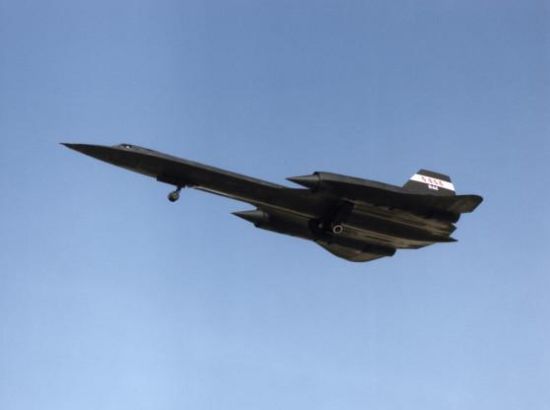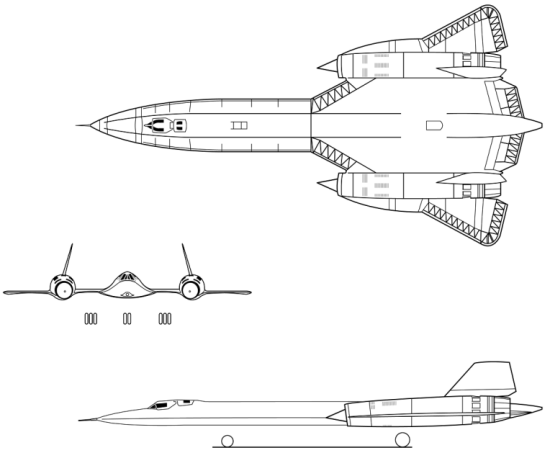|
||||||||||
|
|
||||||||||
|
||||||||||
|
|
||||||||||
 - -
|
|

|
Lockheed SR-71 Blackbird Strategic Reconnaissance |
|
DESCRIPTION:
The remarkable SR-71 is still officially the world's fastest jet-powered plane even some 40 years after it first flew. The Blackbird design began in the late 1950s as a Mach 3 high-altitude interceptor and strike platform. However, the Central Intelligence Agency was growing increasingly concerned about the vulnerability of its U-2 spy planes to Soviet air defenses and foresaw the need for a high-speed, high-altitude replacement. After the CIA realized that the Blackbird would be much better suited to the reconnaissance role than to combat, this need led to the conceptualization of what would become the SR-71 in 1958. Key to reducing the aircraft's vulnerability to air defenses were a maximum speed of Mach 3+ and a ceiling of up to 85,000 ft (25,930 m). However, such performance required unprecedented leaps in design and construction methods. Chief among these challenges was mastering the use of titanium, from which the airframe is constructed to survive the intense heating environment encountered in high-speed flight. Other difficulties arose in the development of jet engines and hydraulic systems that made use of advanced materials to operate at such high speeds. The requirement for long range also dictated an application of advanced aerodynamic principals including a highly-swept delta wing with leading edge camber to minimize induced drag. In addition, the SR-71 incorporates early stealth techniques designed to minimize detectability by radar. Some of the stealth-enhancing methods employed on the SR-71 included a sharply-chined nose, canted vertical tails, and paint designed to scatter radar waves. The first units built were 15 A-12 strike models configured for both reconnaissance and attack missions. These single-seat aircraft were delivered to the CIA beginning in 1962, although one was modified for use as a two-seat trainer and two more gained a second seat for a launch officer to operate a D-21 unmanned drone. These early aircraft could carry a centerline pod containing a 1-megaton nuclear bomb or the D-21 recon drone armed with cameras, infrared sensors, and other equipment. Three new two-seat aircraft were also built as YF-12A high-speed interceptors, but these were primarily employed as research aircraft in conjunction with NASA. The A-12 aircraft were flown by the Air Force on behalf of the CIA until the more advanced SR-71, a dedicated reconnaissance model, became fully operational in 1968. The SR-71 featured an improved airframe, increased fuel capacity, and better aerodynamic performance but lacked the weapons bays of earlier models. The SR-71 was also equipped with in-flight refueling capability to compensate for the design's high fuel consumption and to extend its range. Although much of the capabilities of the SR-71 are still unknown, it is believed that the aircraft could carry a 1-megaton nuclear device or advanced cameras, sensors and reconnaissance equipment. These systems gave the Blackbird the ability to perform surveillance of up to 80,000 square miles (207,000 sq km) per hour. Production is believed to have totalled 32 aircraft, including 29 SR-71A reconnaissasance models, two SR-71B trainers, and a single SR-71C trainer that was rebuilt from one of the YF-12s. Although the SR-71 provided invaluable reconnaissance capabilities over world hot spots throughout the Cold War, it was a very expensive vehicle to maintain and operate. Increasing support costs and decreasing budgets led the Air Force to retire the aircraft, amid much fanfare, in 1990. Three of the retired airframes were placed in storage at Lockheed's Palmdale plant to be reactivated should they be needed. The only models remaining in service were another three SR-71s operated by NASA for high-speed research. However, many felt that the SR-71's services were sorely missed during the 1991 Gulf War. This opinion led Congress to order the reactivation of a portion of the SR-71 fleet in 1994. Since the stored aircraft were deemed no longer airworthy, NASA loaned its two single-seat and one two-seat aircraft back to the Air Force. The single-seat models were refurbished between 1995 and 1996 by Lockheed and upgraded with an Advanced Synthetic Aperture Radar System (ASARS), an Itek camera with full horizon coverage, and two preprogrammed high-resolution cameras. In addition, the aircraft were fitted with a data link to transmit radar imagery in real time. Their new lease on life was short-lived, however, and the Air Force again retired the SR-71 in 1998. These three aircraft remained in limited use by NASA until 2001 when they were finally retired for the last time. Of the 50 A-12s, YF-12s, and SR-71s that were built, 20 were lost in various accidents. Most of the remaining survivors have been donated to museums throughout the United States.
Data below for SR-71A |
|
| HISTORY: | |
| First Flight |
(A-12) 26 April 1962 (SR-71A) 22 December 1964 |
| Service Entry |
(A-12) November 1965 (SR-71) January 1966 |
|
Retirement
|
(A-12) 8 May 1968 (SR-71) 18 January 1990, 3 December 1998 |
| CREW: |
(A-12) one: pilot (M-21) two: pilot, drone launch control officer (YF-12) two: pilot, weapons systems officer (SR-71) two: pilot, reconnaissance systems officer |
|
ESTIMATED COST:
|
$34 million [1966$]
|
| AIRFOIL SECTIONS: | |
| Wing Root | unknown |
|
Wing Tip
|
unknown
|
| DIMENSIONS: | |
| Length |
(A-12) 102.25 ft (31.19 m) (M-21) 102.25 ft (31.19 m) (YF-12) 101.67 ft (30.02 m) (SR-71) 107.42 ft (32.74 m) |
| Wingspan |
(A-12) 55.58 ft (16.96 m) (M-21) 55.58 ft (16.96 m) (YF-12) 55.58 ft (16.96 m) (SR-71) 55.58 ft (16.96 m) |
| Height |
(A-12) 18.50 ft (5.64 m) (M-21) 18.50 ft (5.64 m) (YF-12) 18.50 ft (5.64 m) (SR-71) 18.50 ft (5.64 m) |
| Wing Area | (SR-71) 1,800 ft² (167.22 m²) |
|
Canard Area
|
not applicable
|
| WEIGHTS: | |
| Empty | (SR-71) 60,000 lb (27,215 kg) |
| Normal Takeoff | unknown |
| Max Takeoff |
(A-12) 117,000 lb (53,070 kg) (YF-12) 124,000 lb (56,245 kg) (SR-71) 170,000 lb (77,110 kg) |
| Fuel Capacity |
internal: 80,000 lb (36,290 kg) external: not applicable |
|
Max Payload
|
unknown
|
| PROPULSION: | |
| Powerplant |
(A-12) two Pratt & Whitney J-58 afterburning turbo-ramjets (M-21) two Pratt & Whitney J-58 afterburning turbo-ramjets (YF-12) two Pratt & Whitney J-58 afterburning turbo-ramjets (SR-71) two Pratt & Whitney JT11D-20B afterburning turbo-ramjets |
| Thrust |
(A-12) 60,000 lb (267 kN) (M-21) 80,000 lb (356 kN) (YF-12) 63,000 lb (280 kN) (SR-71) 65,000 lb (289 kN) |
| Fuel Type |
JP-7
|
| PERFORMANCE: | |
| Max Level Speed |
at altitude: 2,275 mph (3,660 km/h) at 80,000 ft (24,385 m), Mach 3.35 [world record] at sea level: unknown |
| Initial Climb Rate | unknown |
| Service Ceiling | 85,500 ft (26,060 m) [world record] |
| Range | 2,590 nm (4,800 km) |
| Endurance | 1 hr 30 min |
| g-Limits |
unknown
|
| ARMAMENT: | |
| Gun | none |
| Stations | 1 external hardpoint |
| Air-to-Air Missile | none |
| Air-to-Surface Missile | none |
| Bomb | nuclear bombs |
| Other |
cameras, IR sensors, radar, other recon sensors (M-21) D-21 drone |
| KNOWN VARIANTS: | |
| Oxcart | Classified designation given to the A-12 project by the CIA |
| Senior Crown | Classified designation given to the SR-71 project |
| A-11 Archangel | Lockheed's internal designation for its proposal to meet the CIA's high-speed reconnaissance aircraft requirement |
| A-12 | Original design concept for a high speed bomber/interceptor, but built as a single-seat recon/strike platform, based on the A-11 design but with improvements to lower the radar cross section; 13 built (5 lost) |
| M-21 | Originally intended as A-12 airframes but modified during construction with a second seat for an officer to operate the D-21 drone, the new designation refers to the aircraft's role as a mothership (M-21) to launch the daughter (D-21) and increase reconnaissance range; 2 built (1 lost) |
| YF-12A | Initially designed as an interceptor prototype equipped with a Hughes AN/ASG-18 pulse-Doppler radar in the nose and tandem weapons bays for AIM-47 air-to-air missiles, later used by NASA as Mach 3 research aircraft; 3 built (2 lost) |
| F-12B | Proposed production model of the YF-12A to serve as a USAF high-speed interceptor; cancelled |
| YF-12C | A-12 airframe modified with increased fuel capacity and other refinements to test many of the improvements incorporated into the SR-71; 1 converted |
| RB-12 | A proposed reconnaissance bomber variant that reached the mockup stage before being cancelled |
| RS-12 | Proposed strike model |
| B-12 or B-71 | Proposed dedicated bomber variants |
| RS-71A | Original designation for the dedicated reconnaissance model |
| SR-71A | Definitive reconnaissance model with aerodynamic refinements, improved airframe, greater range, and fitted with advanced surveillance equipment; 29 built (11 lost) |
| SR-71B | Two-seat trainer with a separate raised cockpit for an instructor pilot; 2 built (1 lost) |
| SR-71C |
Two-seat trainer rebuilt from a YF-12A structural test model and incorporating parts from other crashed
airframes, built to replace one of the SR-71B trainers that was lost, later used by NASA; 1 converted
|
|
KNOWN COMBAT RECORD:
|
overflights of world hotspots
|
|
KNOWN OPERATORS:
|
United States (Central Intelligence Agency) United States (US Air Force) United States (NASA) |
|
3-VIEW SCHEMATIC:

|
|
SOURCES:
|
|


|
Aircraft | Design | Ask Us | Shop | Search |

|
|
| About Us | Contact Us | Copyright © 1997- | |||
|
|
|||